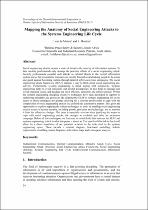 ResearchSpace
ResearchSpace
Underlying finite state machine for the social engineering attack detection model
JavaScript is disabled for your browser. Some features of this site may not work without it.
- ResearchSpace
- →
- Research Publications/Outputs
- →
- Conference Publications
- →
- View Item
Underlying finite state machine for the social engineering attack detection model
Information security is a fast-growing discipline, and relies on continued improvement of security measures to protect sensitive information. In general, human operators are often highly susceptible to manipulation, and tend to be one of the weakest links in the security chain. A social engineering attack targets this weakness by using various manipulation techniques to elicit individuals to perform sensitive requests. The field of social engineering is still in its infancy with respect to formal definitions, attack frameworks, examples of attacks and detection models. In order to formally address social engineering in a broad context, this paper proposes the underlying finite state machine of the Social Engineering Attack Detection Model (SEADM). The model has been proven to successfully thwart social engineering attacks utilising either bidirectional communication, unidirectional communication or indirect communication. Proposing and exploring the underlying finite state machine of the model allows one to have a clearer overview of the mental processing performed within the model. While the current model provides a general procedural template for implementing detection mechanisms for social engineering attacks, the finite state machine provides a more abstract and extensible model that highlights the interconnections between task categories associated with different scenarios. The finite state machine is intended to help facilitate the incorporation of organisation specific extensions by grouping similar activities into distinct categories, subdivided into one or more states. In addition, it facilitates additional analysis on state transitions that are difficult to extract from the original flowchart based model.
Reference:
Mouton, F. et al. 2017. Underlying finite state machine for the social engineering attack detection model. Information Security for South Africa Conference (ISSA2017), 16-17 August 2017, Sandton, Johannesburg, South Africa, pp. 98-105
Mouton, F., Nottingham, A. T., Leenen, L., & Venter, H. (2017). Underlying finite state machine for the social engineering attack detection model. IEEE. http://hdl.handle.net/10204/9913
Mouton, Francois, Alastair T Nottingham, Louise Leenen, and HS Venter. "Underlying finite state machine for the social engineering attack detection model." (2017): http://hdl.handle.net/10204/9913
Mouton F, Nottingham AT, Leenen L, Venter H, Underlying finite state machine for the social engineering attack detection model; IEEE; 2017. http://hdl.handle.net/10204/9913 .
Copyright: 2017 IEEE. Due to copyright restrictions, the attached PDF file only contains the abstract of the full text item. For access to the full text item, please consult the publisher's website.
This item appears in the following Collection(s)
Related items
Showing items related by title, author, creator and subject.
-
Author: Mouton, Francois ; Leenen, Louise ; Venter, HS Date: Jun 2016 The field of information security is a fast-growing discipline. Even though the effectiveness of security measures to protect sensitive information is increasing, people remain susceptible to manipulation and thus the human element remains a ... Read more
-
Author: Mouton, F ; Leenen, L ; Malan, MM ; Venter, HS Date: Aug 2014 The human is often the weak link in the attainment of Information Security due to their susceptibility to deception and manipulation. Social Engineering refers to the exploitation of humans in order to gain unauthorised access to sensitive ... Read more
-
Author: Van de Merwe, J ; Mouton, Francois Date: Nov 2017 Social engineering attacks present a material threat to the security of information systems. To date security professionals only manage the potential effects of a social engineering attack. Security professionals consider such attacks as ... Read more
Browse
-
All of ResearchSpace
-
This Collection
Legislation and compliance
General Enquiries
Tel: + 27 12 841 2911
Email: callcentre@csir.co.za
Physical Address
Meiring Naudé Road
Brummeria
Pretoria
South Africa
Postal Address
PO Box 395
Pretoria 0001
South Africa
Copyright © CSIR 2017. All Rights Reserved
Resources on this site are free to download and reuse according to associated licensing provision. Please read the terms and conditions of usage of each resource.







